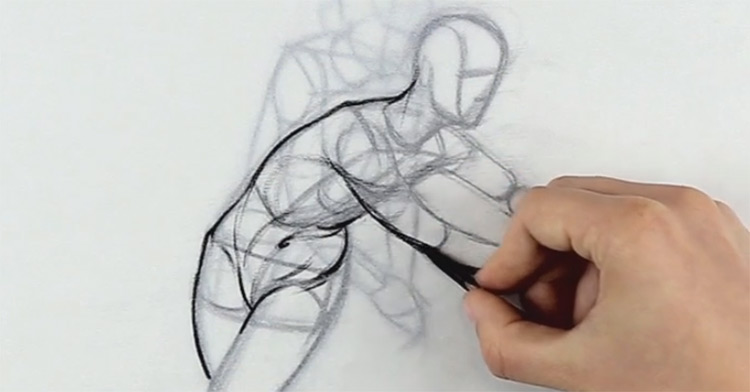Anatomy for artists, Proko Tracing #1
December 7, 2014

http://www.proko.com is in the process of publishing online lessons on anatomy for artists. I’ve not traced over photographs before, but this week I’m working through five of them at the rate of one a day.
Here’s the first, using Derwent Rexel drawing pencils (Burnt Umber and White) on tracing paper over the Proko photograph. Happily, it relates to a big weakness in my understanding of anatomy, the back. Building on my vague, general understanding that the back is dominated by traps and lats, this tracing is helping me to get a handle on the smaller muscles and how they work together.
'review of proko s figure drawing fundamentals course july 10th, 2018 - is the proko figure drawing premium course worth the review of proko’s figure drawing fundamentals course a figure drawing course it does not cover anatomy' 9 / 38 '. Mar 06, 2019 Proko Review – Best Online Figure Drawing Courses Reviews By Mark Roger March 6, 2019 Though artists on their own look super-confident, what lies beneath the surface is hard to fathom. Especially in the case of new artists, there’s plenty to learn to be a thorough professional. Review Of Proko S Figure Drawing Fundamentals Course. Ic Artwork Critique Thread 3682084. Proko S Figure Drawing Fundamentals Lesson 2 Homework Angela R.
My initial sketch is quite rough, in part caused by the incompatibility of the Derwent pencil over an initial underdrawing in graphite HB pencil. I had to use fixative to hold the coloured pencil. Over time, I’m sure details will fall into place. In the meantime, it helps that the model is clearly lit and that the background is white.
Aspects of the pose
Fortuitously, the model is not completely “head-on” to the viewer, obvious from the side profile of the face. Because the arms are raised, there is some foreshortening occurring such that the shoulders are pushed rather more forward to the viewer, slightly ahead of the torso. There is a slight difference between the arms, obvious both from the area around the acromion and the definition in the trapezius, with more flexion visible in the shoulder on the viewer’s right. The upshot of all this is that there will be subtle variations between the right and left sides. This makes the pose more “natural” and less “static”, a point raised in the Proko videoclip relating to proportions in his Figure Drawing series.
The muscle closest to the viewer is the large, flaring traps; its three sections are very clear – the first attached to the back of the skull, the second attached to the acromion and the third attached to the lower spine. In the middle are the two bumps associated with the C7 and the T1 vertebrae. I’m of course drawn to the tonal variation in the traps, but I need to ignore that for the moment.
Immediately below the traps are the small muscles linked to the scapula and it’s obvious that the teres major (and minor) are more pronounced on the right than the left.
Not obvious in my tracing are the crease lines in the traps associated with not just the spine but the position of the illiac crest. I need to review where the ribs are in this position at a later time.
There’s a lot happening in the flexion of the deltoids but for the moment it suffices to reinforce the three bellies of the deltoid. By extension it’s important to reinforce the two (“bi-“) sections of the biceps, even though they are not under much tension. The triceps is also not under tension.
Proko Figure Drawing Review
Textbook references
I made a photocopy of the tracing in order to add the names of the muscles. Civardi (Drawing Human Anatomy) page 39 helps, but only after a re-viewing of the Proko video – for example, where the rhomboid appears on the Proko model. Somewhat more helpful is Richer, Plate 92. Szunyoghy (AnatomyDrawing School) is more specific: see Figs. 123,124.
Figure Drawing Poses
Next steps
Figure Drawing Reference
I don’t want to get too ahead of myself, but it would be great to do this tracing exercise as a freehand study independent of the photographic reference. In the meantime, I’ll pull out some other photographic references where the muscles are exaggerated; I can ‘knock back’ the exaggerated muscles into something more “everyday” later on.